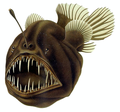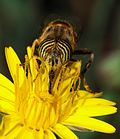Search results
Appearance
The page "Pollination mimicry" does not exist. You can create a draft and submit it for review or request that a redirect be created, but consider checking the search results below to see whether the topic is already covered.
- evolutionary biology, mimicry is an evolved resemblance between an organism and another object, often an organism of another species. Mimicry may evolve between...78 KB (9,197 words) - 14:44, 2 August 2024
- flowers, is also known to aid in pollination of Ophrys species that are normally pollinated by bees. In Batesian mimicry, named after the English naturalist...16 KB (1,836 words) - 20:25, 5 August 2024
- plants employing sexual mimicry, flowers mimic mating signals of their pollinator insects. These insects are attracted and pollinate the flowers through pseudocopulations...31 KB (4,004 words) - 15:37, 19 July 2024
- Pseudocopulation (redirect from Pouyannian mimicry)Allan G.; Johnson, Steven D. (2010). "Floral Mimicry Enhances Pollen Export: The Evolution of Pollination by Sexual Deceit Outside of the Orchidaceae"...10 KB (1,049 words) - 11:06, 6 August 2024
- Aggressive mimicry is a form of mimicry in which predators, parasites, or parasitoids share similar signals, using a harmless model, allowing them to avoid...42 KB (5,011 words) - 22:03, 10 June 2024
- carry out artificial pollination. A pollinator is different from a pollenizer, a plant that is a source of pollen for the pollination process. Plants fall...49 KB (5,591 words) - 06:46, 4 July 2024
- Flower (redirect from Pollinator attraction system)method of transport varies. Flowers can be pollinated by two mechanisms; cross-pollination and self-pollination. No mechanism is indisputably better than...103 KB (11,648 words) - 10:40, 28 July 2024
- Chemical mimicry (or molecular mimicry) is a type of biological mimicry involving the use of chemicals to dupe an operator. A chemical mimic dupes an operator...11 KB (1,398 words) - 23:53, 3 January 2024
- particular pollination they have sometimes created unique flowers with very strange pollination mechanisms. The species of these tribes are pollinated exclusively...39 KB (5,154 words) - 07:38, 3 January 2024
- Wasp (redirect from Pollinator wasp)vast majority of wasps play no role in pollination, a few species can effectively transport pollen and pollinate several plant species. Since wasps generally...63 KB (6,795 words) - 17:29, 19 July 2024
- Hoverfly (section Pollination)mammals, though many species are mimics of stinging wasps and bees, a mimicry which may serve to ward off predators. Hoverfly hovering behavior is unlike...24 KB (2,630 words) - 20:07, 28 June 2024
- Bombylius major (section Mimicry)general pollination, without preference of flower types. The fly does not bite, sting, or spread disease. However, the fly uses this mimicry of bumblebees...17 KB (1,893 words) - 03:39, 5 August 2024
- Eristalis tenax (section Mimicry)are an important but often neglected group of pollinators. They play a significant role in the pollination of agricultural biodiversity and the biodiversity...21 KB (2,687 words) - 15:10, 21 July 2024
- an example of sexually deceptive pollination and floral mimicry, a highly selective and highly evolved plant–pollinator relationship. Ophrys apifera grows...21 KB (2,219 words) - 15:40, 21 June 2024
- as pollinators, among other reasons because they can pollinate plants such as tomato in greenhouses by buzz pollination whereas other pollinators cannot...107 KB (11,594 words) - 03:39, 25 July 2024
- a large bee due to its coloration and size. Their bee mimicry (an example of Batesian mimicry) helps them avoid potential predators. Female tiger bee...5 KB (451 words) - 11:49, 16 May 2024
- Bee (section As commercial pollinators)specialized as pollination agents, with behavioral and physical modifications that specifically enhance pollination, and are the most efficient pollinating insects...118 KB (12,217 words) - 05:34, 29 July 2024
- insects exhibit protective mimicry of aggressive, stinging yellowjackets; in addition to numerous bees and wasps (Müllerian mimicry), the list includes some...16 KB (1,775 words) - 18:12, 4 August 2024
- Carrion flower (category Pollination)for pollinators. In order for pollination to occur, a relationship of attraction and reward must be present between the flower and the pollinator. The...10 KB (1,076 words) - 20:14, 28 October 2023
- opened blossoms, an unusual thing. Since this species is adapted to pollination by wasps, and avoided by other insects which have a respectful awe of
- frightened. Jeremy Clarkson: How do you get wheat to mate? Stephen Fry: Pollination. Jeremy Clarkson: Yes, well, how does that happen? Bill Bailey: You turn
- (1988). "Avian Predation on the Monarch Butterfly and Its Implications for Mimicry Theory". American Society of Naturalists. 131: S4–S6. doi:10.1086/284763



















